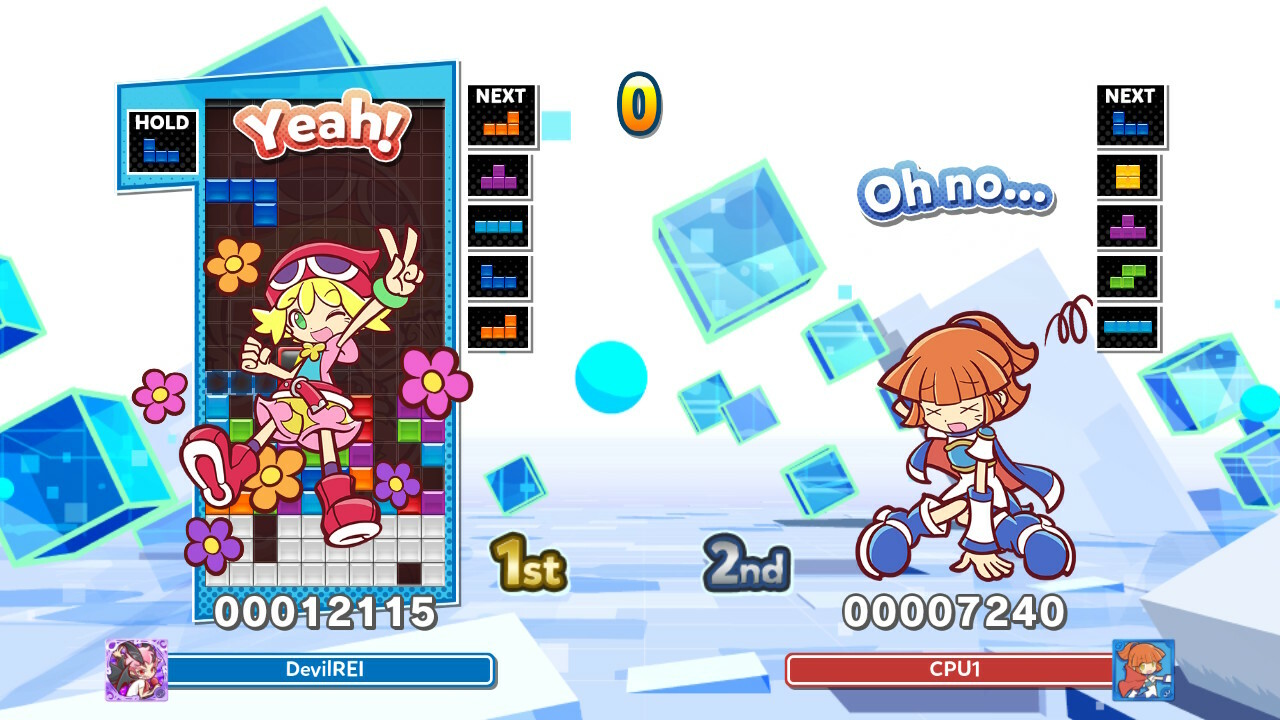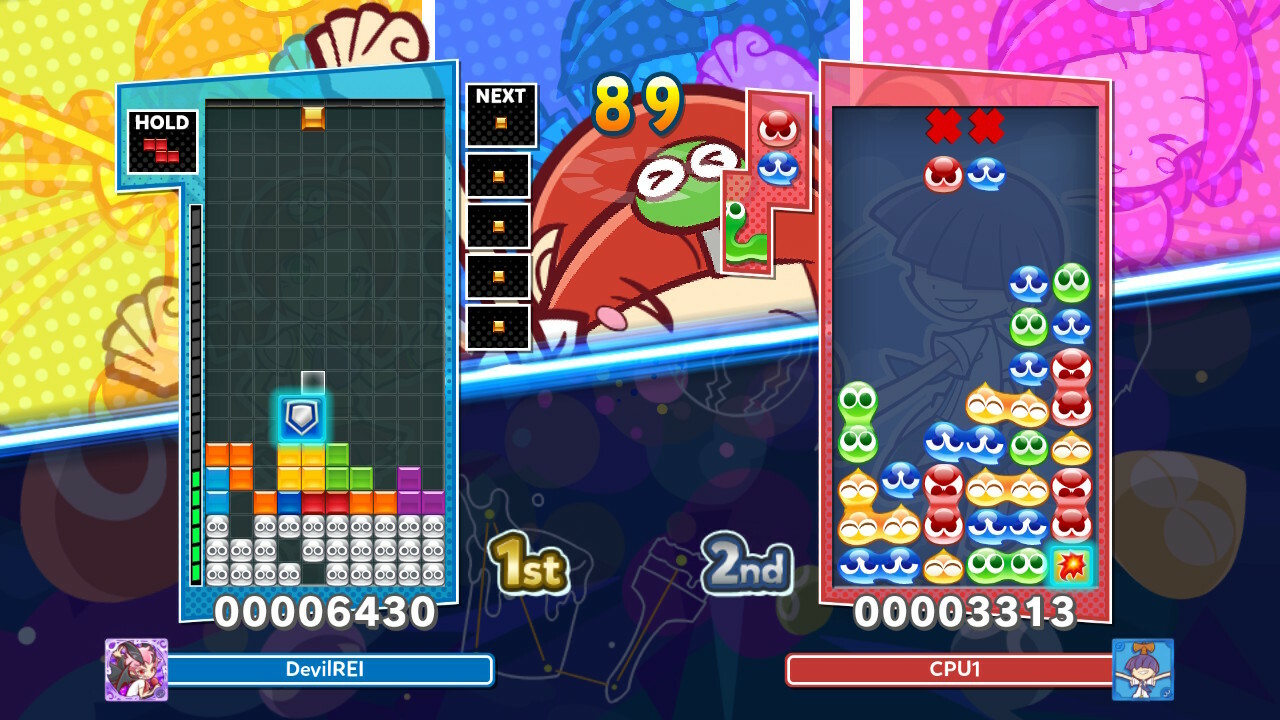Fans of competitive, block-dropping puzzle games had it pretty rough for most of the last decade. Creativity in the Tetris space was being stifled by a strict set of game-rules guidelines imposed by The Tetris Company, while Puyo Puyo was mostly trapped in Japan, playable only by those international fans fervent enough to tread import waters. Thankfully, things have changed somewhat on both fronts, bringing us the unusual mashup title Puyo Puyo Tetris in 2017 to critical and fan success. Three years later, we now have a follow-up in the form of Puyo Puyo Tetris 2. While it keeps much of what made the original game a success, it offers a few new game modes and online enhancements--but as a sequel, it lacks the same punch as the original.
Like in the original game, Puyo Puyo Tetris 2 is built around an engine combining these two competitive puzzle titans into a singular game entity. Players pick either Puyo Puyo or Tetris gameplay and go up against an opponent, with rules adjusted according to which style they're using--or they can play a mode that switches between Puyo Puyo and Tetris gameplay at set intervals. If you're feeling especially brave, you can attempt Fusion mode, which puts Puyo blobs and Tetromino blocks on the same board in a complex rules mashup that will put your puzzling skills to the true test.
But that's just the beginning. There's a lot on offer in Puyo Puyo Tetris 2 for both solo and multiplayer play. The Adventure mode offers an all-new story, complete with a pleasant new overworld interface and featuring a cast of colorful weirdos--mostly from the expanded Puyo Puyo universe--who solve all of their problems and disagreements by tossing colored blobs and blocks at each other. The game modes change in every chapter, so Adventure Mode serves as a way to practice and learn the various styles of gameplay available while also unlocking characters, in-game shop credits, and various embellishments for your profile. While the rainbow-colored characters and their jokey personalities are certainly cute, the nonsensical nature of the narrative will either charm you to bits or leave you mashing the skip button to get to the dropping faster. This mode takes a few hours to finish, and future DLC expansions have been teased.

After you've finished Adventure Mode--or if you want to take a break from it--you have several options for both solo and multiplayer play for up to four people (or CPU bots). Besides all the gameplay styles above, you have special rulesets like Party Mode, which puts chaos-causing items onfield, and Big Bang Mode, a challenge of who can solve certain puzzle formations quicker. If you don't want the stress of competition, there are challenge modes like Marathon (clear 150 Tetris lines) and Tiny Puyo (make a gigantic Puyo combo with a big playfield). Of course, solo endless Puyo and Tetris modes are available as well for those times when you just want to zone out and crush some blocks and/or squish some blobs.
These modes are certainly nice, but most of them were already available in the original Puyo Puyo Tetris. However, there have been some revamps since the first game. For example, the Lessons mode now offers a wealth of playable tutorials to give you hands-on experience with some more advanced techniques. Need to work on your Puyo stacking prowess? Don't have the slightest clue what a T-spin is or how to do it? You can now learn quickly and easily thanks to this thoughtful new addition. There are also new visual flourishes ranging from the subtle to the flashy, including an impressively elaborate background animation when a player has a particularly high combo happening.
Of course, a big draw for competitive puzzlers is online play, and Puyo Puyo Tetris 2 delivers on that front. Besides offering a ranked mode in the form of Puzzle Leagues, you can also play casual matches with friends or random players across several different game modes with an easy-to-use lobby system. Online play is smooth and hassle-free, and I had no connectivity issues with players as far away as Europe and Australia, even on Wi-Fi.
The marquee feature in Puyo Puyo Tetris 2, however, is the Skill Battle mode. In this mode, you form a team of three characters, each with individual stats and battle skills, to fight an opponent's team of three. You can also equip special items earned through certain quests in Adventure Mode to further augment your team's stats and grant additional boons, such as bonuses to chains.
You then proceed to pick your game of choice and square off against a foe, but instead of trying to make them top out, you set off combos and complete line clears to deal damage to their health bar. You'll also be able to make use of the three character skills you have assigned, which have a variety of effects ranging from changing colors of Puyos to clearing up garbage waiting to be dropped--you can even spontaneously create a perfect set of lines for a Tetris or T-Spin combo instantly. Provided, of course, that you have the MP available to do so. It's a cool idea, and the shift in focus to damaging an opponent's lifebar instead of making them top out adds a new way to think about offensive and defensive play--in some Skill Battle setups, topping out and getting a clean board to work with is actually a good thing if you have recovery options in place.

However, the most interesting elements of Skill Battle are undermined by its implementation of RPG-style stats and enhancement items. Characters gain experience points in certain Adventure Mode nodes, which grants them better stats, and helpful items to equip are also farmable in these areas. These items and stats carry over to every other Skill Battle mode, both single-player and multiplayer, on- and offline, including the Puzzle League. This leads to some serious problems: If you're underleveled or lack good items compared to your opponent, you're at a severe disadvantage that skilled play and technique usage can only slightly compensate for. Needing to grind for items and levels in a puzzle game simply to be competitive--or even just to beat some of the tougher Adventure Mode quests--is tedious and unfair on several levels, and ruins much of Skill Battle's appeal. I suspect that eventually the Skill Battle leaderboards will be dominated by level 99 teams that have poured hours into securing optimal item loadouts, leaving new players with an incredible hill to climb if they even want to become slightly competitive.
There's no denying that Puyo Puyo Tetris 2 offers a lot of value--and even if you're just here for simple Tetris or Puyo play, there's plenty to satisfy. But as a sequel, the new additions it brings to the table feel rather inadequate, particularly the flawed Skill Battle mode. If you've never had a taste of this flavorful mashup before, then Puyo Puyo Tetris 2 will certainly quench your thirst for wacky puzzle antics and then some. But if you're a veteran looking for a truly substantial upgrade to the original game, Puyo Puyo Tetris 2 might leave you feeling rather unfulfilled.













